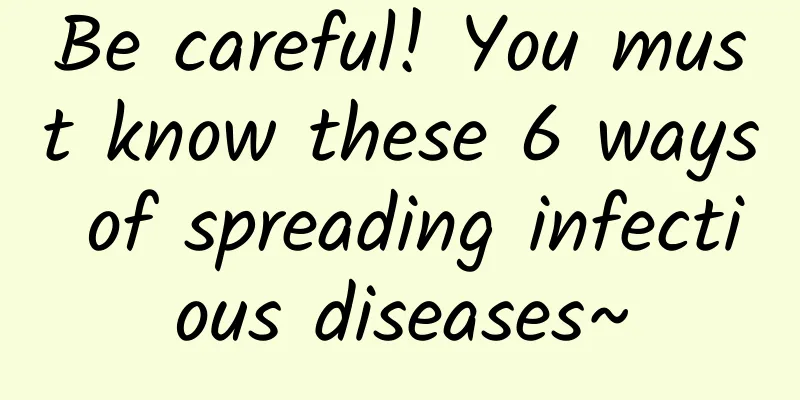Be careful! You must know these 6 ways of spreading infectious diseases~

|
Review of this article: Zhang Jieli, Deputy Chief Nurse, Fifth Medical Center, PLA General Hospital Zhang Xin, Deputy Chief Physician, Fifth Medical Center, PLA General Hospital Why is separate dining a healthy eating habit? Why should we be careful about mosquito breeding in our living environment? Why can we use hugs to convey encouragement to AIDS patients? Because gastrointestinal transmission and insect-borne transmission are the routes of transmission of infectious diseases; blood, body fluids and mother-to-child transmission are the routes of transmission of AIDS, while physical contact during hugging is not. Yes, these are actually related to scientific prevention of infectious diseases. Respiratory tract transmission, digestive tract transmission, contact transmission, insect-borne transmission, blood or body fluid transmission and mother-to-child transmission are the six ways of infectious disease transmission. 1. Respiratory transmission Copyright image, no permission to reprint After the pathogens are discharged from the body of the infectious source, they exist in droplets or aerosols in the air, causing infection when inhaled by the human body. For example: measles, tuberculosis, chickenpox, influenza, severe acute respiratory syndrome and new coronavirus pneumonia. 2. Digestive tract transmission Copyright image, no permission to reprint After the pathogens are excreted, they contaminate food, water or tableware, causing people to be infected through the mouth when eating or drinking. Infants and young children can be infected through contaminated milk or bottles or nipples. For example: bacterial dysentery, typhoid, cholera, rotavirus infection, etc. 3. Contact transmission Copyright image, no permission to reprint After pathogens are discharged from the body of the source of infection, they contaminate the soil, objects, etc., and people are infected when they come into direct or indirect contact with the contaminants. For example: leptospirosis, schistosomiasis and hookworm disease, etc. Some diseases may also cause infection when close contact is made in daily life, such as influenza, diphtheria, etc. Unclean sexual contact can spread AIDS, hepatitis B, hepatitis C, syphilis, gonorrhea, etc. 4. Insect-borne transmission Copyright image, no permission to reprint Mainly blood-sucking arthropods (such as mosquitoes, lice, rat fleas, sand flies, hard ticks, chiggers, etc.) transmit pathogens to others when they bite. For example: malaria, Lyme disease, epidemic typhus, etc. 5. Transmission through blood and body fluids Copyright image, no permission to reprint Pathogens can be transmitted to others through blood transfusion, use of blood products, organ transplantation, etc. For example: AIDS, hepatitis B, hepatitis C, etc. 6. Mother-to-child transmission Copyright image, no permission to reprint For some infectious diseases, the pathogens can infect the fetus through the placenta or through the birth canal during natural delivery. For example: AIDS, hepatitis B, etc. Another part can cause ascending transmission, that is, pathogens reach the chorion or placenta from the vagina of pregnant women and cause intrauterine infection of the fetus, such as herpes simplex virus, cytomegalovirus, etc. The spread and prevalence of infectious diseases are affected by natural and social factors. The survival and reproduction of all pathogens can be influenced and controlled by natural factors such as geography, meteorology, and ecological conditions. Some viruses are not resistant to high temperatures. In addition, the defense ability of the human respiratory mucosa decreases in winter and spring. Therefore, respiratory infectious diseases such as measles and chickenpox are more common in winter and spring. Schistosomiasis must rely on snails to survive, and snails can only live in water areas with mild climate, sufficient rainfall and overgrown weeds. Therefore, in my country, schistosomiasis is mostly prevalent in areas south of the Yangtze River. Japanese encephalitis is only transmitted by mosquitoes, and mosquitoes require specific temperature and humidity to reproduce. Therefore, in my country, Japanese encephalitis basically occurs in summer and autumn. Social factors that affect infectious diseases include social system, economic conditions, living conditions, cultural level, and hygiene concepts. After the founding of New China, the superiority of the socialist system has continued to emerge, people's living standards have continued to improve, and the country has implemented planned immunization, which has significantly reduced the incidence of many infectious diseases or nearly eliminated them. However, as the national economy continues to grow, the incidence of certain infectious diseases, such as AIDS, is gradually increasing due to factors such as population mobility, environmental pollution, and behavioral changes; or some new infectious diseases, such as SARS and new coronavirus pneumonia, are emerging. These should attract our attention. Author: Chen Dianjie, Fifth Medical Center, PLA General Hospital Source: Chinese Medical Association's "Popularizing Chinese Medical Health" project The watermarked images and cover images in this article are from the copyright gallery, and the image content is not authorized for reprinting |
>>: The manned lunar landing drama is about to begin. Who has the ability to "occupy" the moon?
Recommend
The efficacy and function of mountain chrysanthemum
I believe many people are familiar with the Chine...
New research finds that eating this kind of food can improve your liver!
Recent studies have shown that eating a diet rich...
Can Dendrobium candidum be eaten in summer?
We all know that for some weak people, they usual...
The efficacy and function of dog's foot grass root
The world is full of wonders, and Chinese medicin...
Effects and functions of cinnamon wood
I wonder if you have ever heard of cinnamon bark....
Psyllium
Psyllium has always been used as a laxative and h...
Why do allergies always occur in spring?
Spring is supposed to be a beautiful season full ...
The role of thickening
The cooking methods in every region of China are ...
Parents, please note that these children's masks do not meet the standards! How to protect infants and young children under 3 years old?
↓Recently State Administration for Market Regulat...
Two "hikers" fell off a cliff while rock climbing! Six principles to keep in mind for high-risk outdoor sports
Expert interviewed: Su Hao, professor of the Scho...
The efficacy and function of vine bark
As a traditional Chinese medicine, do you know th...
"Mask Companion" is all over the Internet! Cool down in 1 second, refreshing and not stuffy? Doctors urgently remind: It may induce disease
Expert of this article: Wang Qian, attending phys...
The efficacy and function of a medicinal root
Chinese medicinal materials are very common, and ...
The efficacy and function of stone cream
Stone frost is often used as a medicinal ingredie...
Those common fancy home fertilization methods are actually useless...
It is better to eat without meat than to live wit...









